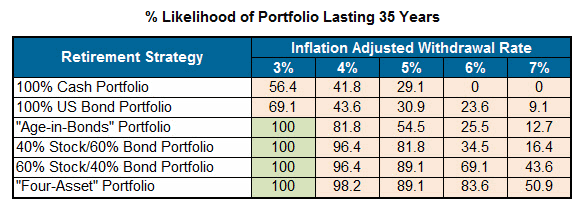Compass Investors
HORIZONTM
A simple, safe and effective approach
for managing your investments.
In a recent article, “The Importance of Diversification in Retirement Portfolios,” Craig Israelsen analyzed six traditional retirement investment portfolios over 55 rolling 35-year periods from 1926 through 2014 to see how long each portfolio would have survived assuming different withdrawal rates. The portfolios studied are listed below from most conservative to more aggressive.
100% Cash
100% US bonds
"Age-in-Bonds"—an annual reallocation to US bonds equal to the age of the investor with the remaining balance allocated to the S&P 500 index.
40% S&P 500 Index/60% US bonds
60% S&P 500 Index/40% US bonds
"Four-Asset" Portfolio—25% in each of the S&P 500 Index, U.S. small-cap stocks, US bonds and cash rebalanced annually
Likelihood of a Portfolio Lasting 35 Years. The table below shows the percentage of time each portfolio studied lasted for 35 years given the specified inflation-adjusted withdrawal rate. Values other than 100% (shaded orange) indicate that the portfolio ran out of money at some point during the periods studied.

Further support for maintaining an adequate exposure to stocks while in retirement can be found in an article by Charles P. Jones and Jack W. Wilson entitled, "Asset Allocation Decisions—Making the Choice Between Stocks and Bonds." Here the authors conclude that "The historical return patterns of asset classes do not support the common advice to increase bond percentages with age. Over time, the real return on bonds is not only small, but declines."
Conclusions
None of the six studied strategies ensured survival above a modest 3% withdrawal rate. Note: Given many retirees are now entering retirement with inadequate account balances, it is inevitable that many will require a withdrawal rate higher than 3% just to provide for the basic necessities of life during retirement.
Contrary to the conventional wisdom to invest more conservatively in stable value, cash and bonds as one ages, the odds of surviving retirement actually decline as the percentage of conservative investments go up.
— Kevin L. Coppola, President, Compass Investors, LLC